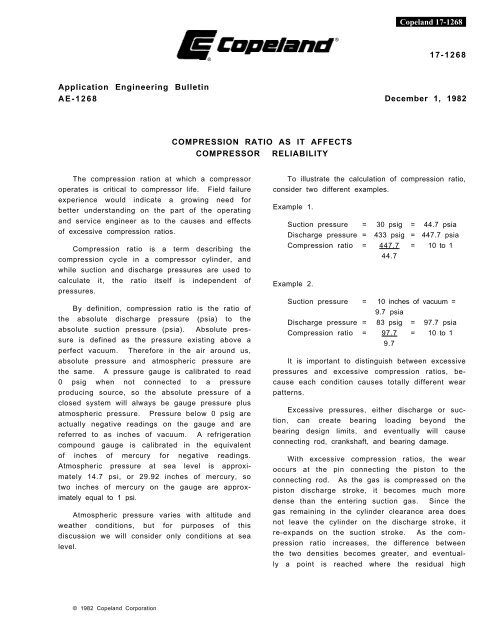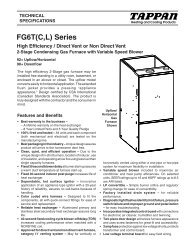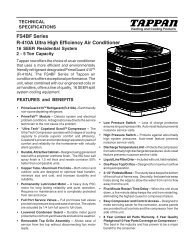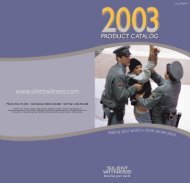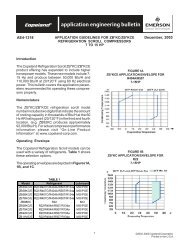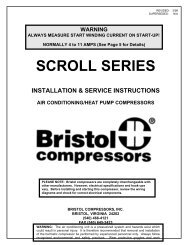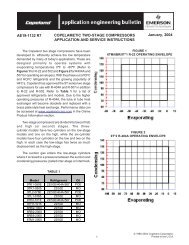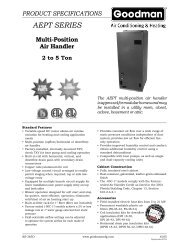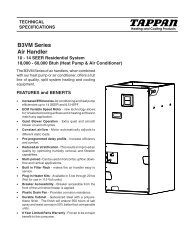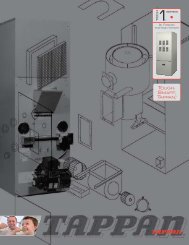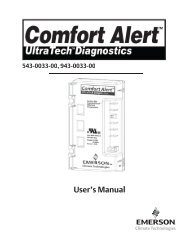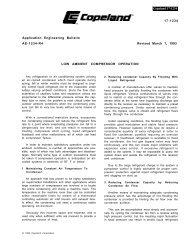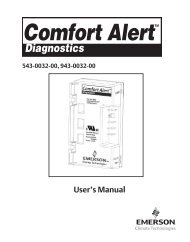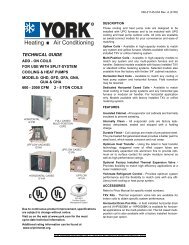Copeland 17-1268 COMPRESSION RATIO AS IT AFFECTS ...
Copeland 17-1268 COMPRESSION RATIO AS IT AFFECTS ...
Copeland 17-1268 COMPRESSION RATIO AS IT AFFECTS ...
Create successful ePaper yourself
Turn your PDF publications into a flip-book with our unique Google optimized e-Paper software.
<strong>Copeland</strong> <strong>17</strong>-<strong>1268</strong>®®<strong>17</strong>-<strong>1268</strong>Application Engineering BulletinAE-<strong>1268</strong> December 1, 1982<strong>COMPRESSION</strong> <strong>RATIO</strong> <strong>AS</strong> <strong>IT</strong> <strong>AFFECTS</strong>COMPRESSOR RELIABIL<strong>IT</strong>YThe compression ration at which a compressoroperates is critical to compressor life. Field failureexperience would indicate a growing need forbetter understanding on the part of the operatingand service engineer as to the causes and effectsof excessive compression ratios.Compression ratio is a term describing thecompression cycle in a compressor cylinder, andwhile suction and discharge pressures are used tocalculate it, the ratio itself is independent ofpressures.By definition, compression ratio is the ratio ofthe absolute discharge pressure (psia) to theabsolute suction pressure (psia). Absolute pressureis defined as the pressure existing above aperfect vacuum. Therefore in the air around us,absolute pressure and atmospheric pressure arethe same. A pressure gauge is calibrated to read0 psig when not connected to a pressureproducing source, so the absolute pressure of aclosed system will always be gauge pressure plusatmospheric pressure. Pressure below 0 psig areactually negative readings on the gauge and arereferred to as inches of vacuum. A refrigerationcompound gauge is calibrated in the equivalentof inches of mercury for negative readings.Atmospheric pressure at sea level is approximately14.7 psi, or 29.92 inches of mercury, sotwo inches of mercury on the gauge are approximatelyequal to 1 psi.Atmospheric pressure varies with altitude andweather conditions, but for purposes of thisdiscussion we will consider only conditions at sealevel.To illustrate the calculation of compression ratio,consider two different examples.Example 1.Suction pressure = 30 psig = 44.7 psiaDischarge pressure = 433 psig = 447.7 psiaCompression ratio = 447.7 = 10 to 144.7Example 2.Suction pressure = 10 inches of vacuum =9.7 psiaDischarge pressure = 83 psig = 97.7 psiaCompression ratio = 97.7 = 10 to 19.7It is important to distinguish between excessivepressures and excessive compression ratios, becauseeach condition causes totally different wearpatterns.Excessive pressures, either discharge or suction,can create bearing loading beyond thebearing design limits, and eventually will causeconnecting rod, crankshaft, and bearing damage.With excessive compression ratios, the wearoccurs at the pin connecting the piston to theconnecting rod. As the gas is compressed on thepiston discharge stroke, it becomes much moredense than the entering suction gas. Since thegas remaining in the cylinder clearance area doesnot leave the cylinder on the discharge stroke, itre-expands on the suction stroke. As the compressionratio increases, the difference betweenthe two densities becomes greater, and eventuallya point is reached where the residual high© 1982 <strong>Copeland</strong> Corporation
<strong>Copeland</strong> <strong>17</strong>-<strong>1268</strong>pressure gas actually presses the piston down formost of the down stroke, not only preventingsuction gas from entering the cylinder, but morecritically keeping the piston pin, starving the pin oflubrication and creating a wear pattern. Eventuallythe round pin hole in the connecting rod willbe worn egg shaped, and from that point on theplay between rod and pin will quickly accelerateadditional wear.Enlarging and strengthening the rod and pinbearing surfaces will increase the compressor’sability to withstand high compression ratios, butthe only way to prevent pin damage is tomaintain the compressor’s operation within allowablelimits. Compressors are capable ofoperating within the limits of their recommendedoperating parameters without piston pin stress,but operation beyond those limits can cause pindamage.Field failures of this type can result fromoperation after losing a condensing fan motor,operating under loss of charge conditions, ormore commonly, from operation at excessivelylow suction pressures. The service engineer whosets the low pressure control for a lower cut-outpoint beyond the compressor design limits toobtain a lower evaporating temperature may beunknowingly starting a failure pattern. Thenumber of low pressure controls that are foundbottomed out in field investigations indicates thisis not an uncommon occurrence.Changes in suction pressure at low evaporatingtemperatures have a much greater affect oncompression ratio than the same pressure differenceat higher pressures, so the field setting ofthe low pressure control is obviously the mostcritical area, as shown in Table 1.It has been a commonly accepted industry ruleof thumb that compression ratios above 10 to 1were the limits of a compressor’s capability, butthe figures in Table 1 clearly demonstrate thatcompression ratios of that magnitude are routinein every supermarket, and must be exceeded forair-cooled operation of low temperature systemsin desert areas.Both compressor construction and time ofexposure are critical factors in determining acompressor’s capability to withstand high compressionratios. Lighter duty welded compressorssuch as the Copelaweld normally should not beapplied beyond compression ratios or 7.5 to 1.The heavier duty Copelametic models can operateat compression ratios up to 15 to 1 and higher forreasonable periods of time, but for long life,compression ratios of 12 to 1 or less aredesirable.While there has not been any laboratory testingto evaluate the effects of operating in a vacuumwith some of the non-standard refrigerants suchas R-13, field experience indicates wear patternsof a similar nature may be aggravated at lowercompression ratios with R-13 than with R-502,Table 1Effects Of Changes In Pressure On Compression Ratio With R-502Condensing Evaporating CompressionTemperature PSIG PSIA Temperature PSIG PSIA Ratio110°F 247.9 262.6 0°F 31.08 45.78 5.7-10°F 22.56 37.26 7.1-20°F 15.31 30.01 8.8-30°F 9.20 23.90 11.0-40°F 4.11 18.80 14.0-50°F .2” 14.60 18.0-60°F 7.15” 11.18 23.5100°F 216.2 230.9 -30°F 9.20 23.90 9.7110°F 247.9 262.6 11.0120°F 282.7 297.4 12.4130°F 320.8 335.5 14.02
which could mean the solvent qualities of someof the ultra low temperature refrigerants may bea complicating factor.In addition to the piston pin wear problem,excessive compression ratios are directly related<strong>Copeland</strong> <strong>17</strong>-<strong>1268</strong>to excessive discharge temperatures. It is possiblethat excessive discharge temperatures can becontrolled by liquid desuperheating valves orother means, but the basic mechanical wearproblem can only be prevented by operatingwithin acceptable limits.3
<strong>Copeland</strong> <strong>17</strong>-<strong>1268</strong>®®<strong>Copeland</strong> CorporationSidney, Ohio 45365-0669 U.S.A.Printed in U.S.A.


